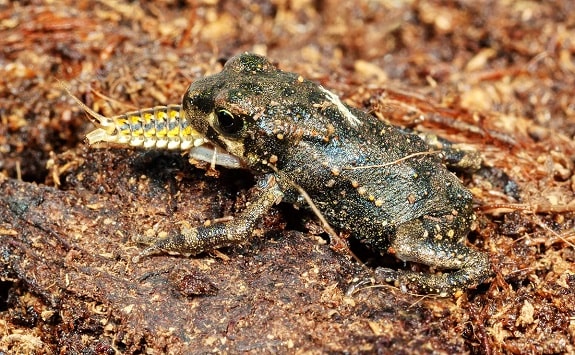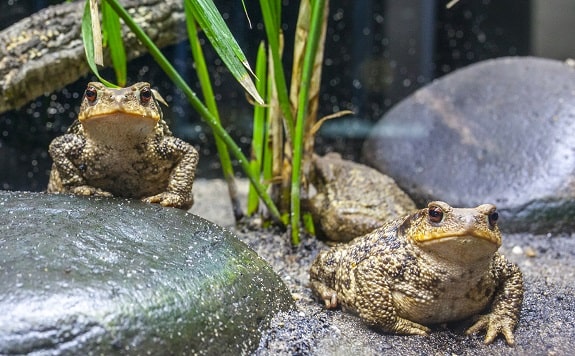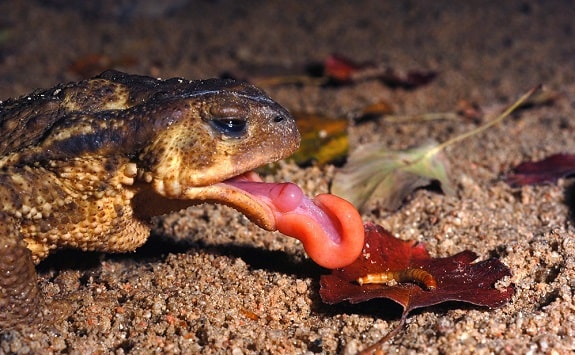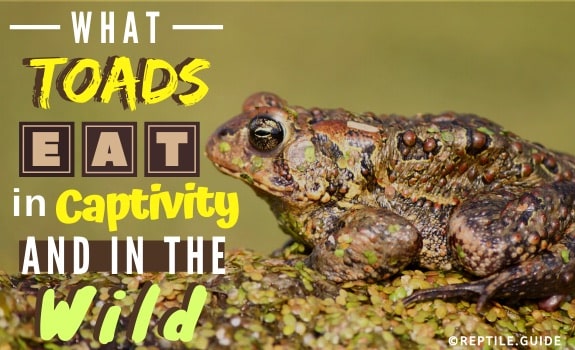Some people may believe that toads have a face that only a mother could love, but we adore them!
Their cute, beady eyes, warty green skin, lazy take on hopping, their ravenous appetite, and their willingness to shovel anything that fits into their mouth are relatable and adorable. They’re like the outgoing, clumsy cousin of frogs (opens in a new tab).
Luckily, it’s pretty easy to fulfill your toad fix.
Perhaps you’re hoping to offer your wild toad neighbors a snack, or even bring them inside and give them a taste of the good life – room service and food delivery, galore.
In any case, you might be interested in finding out about their favorite foods.
Before we dive in, let me say that an article about what they won’t eat could’ve been even shorter than this list. In fact, it’s no wonder so many frog lovers and pet owners decide to name their toads (and frogs) after their favorite foods!
But, I digress, it’s time to find out more about the diet of these little piggies of the anuran world!
What Toads Eat In the Wild

Wild toads are referred to as ambush predators. This means that they don’t actively track and hunt their prey.
Instead, they find a comfortable spot where they can blend into their surroundings, avoiding detection by their prey.
Their excellent vision lets them lock onto small movements made by their prey, then its a matter of waiting until it gets close enough.
You may know toads to be slow and sluggish, but you will soon see otherwise when you see your warty pal spring into action.
Toads have no teeth or ability to chew, so they must eat their prey whole.
Luckily for them, their mouths are quite large – so they can eat rather large whole prey.
Insects
- Beetles
- Bees
- Crickets
- Flies
- Locusts
- Mealworms and other grubs
Insects make up most of a wild toad’s diet.
If it can fit into their mouth (and most insects can), they’ll eat it. Flies can be particularly enticing to some toads.
Gastropods
- Slugs
- Snails
Gardeners usually welcome toads to their yards with open arms and hearts.
Snails and slugs can quickly destroy a green thumb’s hard work, but a healthy population of toads will keep the gastropods in check.
Annelids
- Earthworms
Have you ever seen earthworms come to the surface after a prolonged, hard rain? Well, from now on, you can just refer to this phenomenon as a “toad buffet.”
You can see just how quick toads are to snatch up a tasty worm for yourself by watching the video below!
Rodents
- Mice
- Voles
- Baby rats
This might be the second most surprising category of a wild toad’s diet – but it’s true!
These opportunistic predators will happily eat small mice, voles, and even baby rats in any nests that they might find. Again, anything they can fit in their mouth is fair game.
Arachnids
- Spiders
- Scorpions
Arachnophobes delight! Welcoming toads into your yard may help you keep your resident population of eight-legged creepy crawlies at bay.
Cannibalism
- Toad eggs
- Toad tadpoles
- Juvenile toads
Remember how we said that rodents are the second most surprising category? Well, here’s the first place winner.
Toads really don’t care – if it moves, it is delicious. A toad will gleefully devour its own offspring if it gets the chance.
⭐️ Fun Fact: Did you know, all toads are frogs, but not all frogs are toads? It’s true! We’re breaking down this popular (but unintuitive) saying in plain English once and for all. Discover for yourself what exactly this saying means here.
What Toads and Frogs Eat (In Captivity as Pets)

Now you know what your wild toad buddies are dining on in your yard – but what about if you want to buy a quick snack for them, or a full five-course meal for your captive anuran?
Luckily, most pet stores are well-stocked with live, canned, and dried toad delicacies. You can even grab some grubalicious snacks from your local grocery, fishing, or gardening supply store
Many toads, especially toads that grew up in the wild, will only be interested in living, moving food items.
However, some captive-born toads and even smart, hungry wild-caught toads will go for things meant for human consumption like chunks of meat.
Here’s what to look for, depending on where you’re shopping and what you’re shopping for, in order from easiest to hardest to find.
Pet or Reptile Store
Live
These food items move around, so they are visually enticing to almost all toads.
- Crickets
- Mealworms
- Superworms
- Roaches
- Hornworms
- Feeder Minnows and Guppies
- Pinky Mice
Canned
Canned food has the disadvantage of not wiggling around, but they retain more tempting odors than their dried counterparts.
- Crickets
- Mealworms
- Grasshoppers
- Snails (de-shelled)
- Shrimp
- Superworms
- Black Soldier Fly Larvae
- Silkworms
- Roaches
Dried
Dried insects are convenient and cost-effective, but many toads just won’t be interested in them. Still, it doesn’t hurt to try.
- Mealworms
- Crickets
- Shrimp
Bait Shop
Live fishing bait can make the perfect meal for your toad, and they offer some varieties of food that you may not be able to find in a pet store.
- Red worms
- Nightcrawlers
- Waxworms
- Mealworms
- Butter worms
- Green worms
Gardening Supply Store
Again, an outside-of-the-box source of toad snacks in the form of earthworms that are commonly used for composting.
Grocery Store
In a pinch, you may even be able to find suitable food for your toad at the grocery store.
Just keep in mind that toads primarily hunt by sight, so they may be completely uninterested in a slice of meat that doesn’t move, doesn’t smell like their usual prey, and doesn’t look like their usual prey.
Here are some things you could try:
- Ground beef
- A small chunk of beef or pork
- Beef liver
- Beef heart
- Tilapia or other seafood
- Soft fruits and vegetables
Other Nutritional Requirements of Toads

Offering an occasional free snack to a wild toad is perfectly fine. In fact, it’s an excellent opportunity to observe their feeding behaviors, entertain and teach children about these cute creatures, and interact with nature.
Providing a proper diet to your captive toad is slightly different. It requires a little more thought, planning, and effort.
Since pet toads don’t have access to the same diet variety that they have in the wild, and since farm-raised bugs have lower nutrient profiles than insects in the wild, a captive toad fed only a diet of crickets directly from the pet store can quickly become deficient in specific nutrients.
You can combat this by offering as wide of a variety of food as you can, gut-loading your crickets and roaches with fresh, healthy fruits and veggies, and dusting all feeder insects with vitamin and mineral powder.
Typically, grubs like mealworms, super worms, and black soldier fly larvae contain more nutrients than crickets, but they are also higher in fat.
It’s not unheard of for these little hopping garbage disposals to eat themselves into obesity when given a chance, so keep an eye on their warty waistline!
UVB Lighting
It is still debated whether or not toads require UVB lighting, but it is undoubtedly beneficial for their digestion and provides a helpful Vitamin D3 boost.
Water
As far as water goes, it is always ideal to offer your toad bottled water rather than tap water.
Toads are amphibians, and amphibians absorb water through their skin.
Tap water can contain harmful chemicals and heavy metals that might make your toad sick.
Fruits and Vegetables
Finally, while some toads will eat soft fruits and vegetables, it is definitely not necessary in their diet. In fact, they are strict carnivores.
If your hoppin’ pal enjoys fruits and vegetables, they’re okay to offer, but consider them to be a treat and feed them accordingly.
